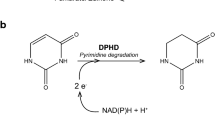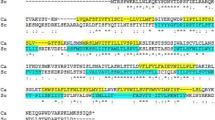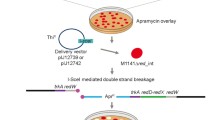Abstract
The primary step in the aromatic amino-acid biosynthetic pathway inSaccharomyces cerevisiae is catalyzed by two redundant isozymes of 3-deoxy-d-arabino-heptulosonate-7-phosphate (DAHP) synthase, either of which alone is sufficient to permit growth on synthetic complete media lacking aromatic acids (SC-Aro). The activity of one isozyme (encoded by theARO3 gene) is feedback-inhibited by phenylalanine, whereas the activity of the other isozyme (encoded by theARO4 gene) is feedback-inhibited by tyrosine. Transcription of both genes is controlled by GCN4. We previously cloned theARO3 gene from the opportunistic pathogenCandida albicans and found that: (1) it can complement anaro3 aro4 double mutation inS. cerevisiae, an effect inhibited by excess phenylalanine; and (2) its expression is induced in response to amino-acid deprivation, consistent with the presence of two putative GCN4-responsive promoter elements (Pereira and Livi 1993, 1995). To determine whether other DAHP synthases exist inC. albicans, we have constructed a homozygousaro3-deletion mutant strain. Such a mutant was found to be phenotypically Aro+, i.e., capable of normal growth on SC-Aro media, suggesting the presence of at least one additional isozyme. To confirm this result, a 222-bp DNA fragment was amplified by the polymerase chain reaction (PCR) from genomic DNA prepared from the homozygousaro3-deletion mutant, using a degenerate primer based on a conserved N-terminal region of Aro3p plus a degenerate comeback primer encoding a conserved region of the protein that lies within the deleted portion of the gene. The nucleotide sequence of this PCR fragment predicts a 74-amino acid DAHP synthase-related protein which shows strong homology to Aro3p fromS. cerevisiae andC. albicans, but even greater homology (78% identity) toS. cerevisiae Aro4p. We conclude that cells ofC. albicans contain a second Aro4p-related DAHP synthase.
Similar content being viewed by others
References
Alani E, Cao L, Kleckner N (1987) Genetics 116:541–545
Bentley R (1990) Crit Rev Biochem Mol Biol 25:307–384
Braus GH (1991) Microbiol Rev 55:349–370
Boeke JD, Lacroute F, Fink GR (1984) Mol Gen Genet 197:345–346
Dvereux J, Haeberli P, Smithies O (1984) Nucleic Acids Res 12:387–395
Fonzi WA, Irwin MY (1993) Genetics 134:717–728
Gillum AM, Tsay EYH, Kirch DR (1984) Mol Gen Genet 198: 179–182
Gorman JA, Chan W, Gorman JW (1991) Genetics 129:19–24
Hicks JB, Herskowitz I (1976) Genetics 83:245–258
Hinnebusch AG (1988) Microbiol Rev 52:248–273
Hinnebusch AG (1990) Prog Nucleic Acid Res Mol Biol 38:195–240
Hinnen A, Hicks JB, Fink GR (1978) Proc Natl Acad Sci USA 75:1929–1933
Jensen RA, Ahmad S (1988) Microbiol Sci 5:316–319
Kelly R, Miller S, Kurtz MB, Kirsch DR (1987) Mol Cell Biol 7:199–207
Kirsch DR, Whitney RR (1991) Infect Immun 59:3297–3300
Kunzler M, Paravicini G, Egli CM, Iriger S, Braus GH (1992) Gene 113:67–74
Kurtz MB, Cortelyou MW, Kirsch DR (1986) Mol Cell Biol 6:142–149
Losberger C, Ernst JF (1989) Curr Genet 16:153–157
Lloyd AT, Sharp PM (1992) Nucleic Acids Res 20:5289–5295
Manning M, Snoddy CB, Fromtling RA (1984) Can J Microbiol 30:31–35
McLaughlin MM, Bossard MJ, Koser PL, Cafferkey R, Morris RA, Miles LM, Strickler J, Bergsma DJ, Levy MA, Livi GP (1992) Gene 111:85–92
Mullis KB, Faloona FA (1987) Methods Enzymol 155:335–350
Nimmo GA, Coggins JR (1981) Biochem J 199:657–665
Ostrander DB, Gorman JA (1994) Gene 148:179–185
Paravicini G, Braus GH, Hutter R (1988) Mol Gen Genet 214:165–169
Paravicini G, Mosch H-U, Schmidheini T, Braus G (1989) Mol Cell Biol 9:144–151
Pereira SA, Livi GP (1993) Gene 132:159–165
Pereira SA, Livi GP (1995) Cell Biol Int 19:65–59
Perfect JR, Toffaletti DL, Rude TH (1993) 61:4446–4451
Sanger F, Nicklen S, Coulson AR (1977) Proc Natl Acad Sci USA 74:5463–5467
Sathe GM, O'Brien S, McLaughlin MM, Watson F, Livi GP (1991) Nucleic Acids Res 19:4775
Shepherd M (1985) Infect Immun 50:541–544
Sherman F, Fink GR, Hicks JB (1986) Methods in yeast genetics. Cold Spring Harbor Laboratory, Cold Spring Harbor, New York
Teshiba S, Furter R, Niederberger P, Braus G, Paravicini G, Hütter R (1986) Mol Gen Genet 205:353–357
Author information
Authors and Affiliations
Additional information
Communicated by R. Rothstein
Rights and permissions
About this article
Cite this article
Pereira, S.A., Livi, G.P. Aromatic amino-acid biosynthesis inCandida albicans: identification of theARO4 gene encoding a second DAHP synthase. Curr Genet 29, 441–445 (1996). https://doi.org/10.1007/BF02221512
Received:
Issue Date:
DOI: https://doi.org/10.1007/BF02221512




